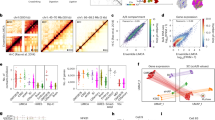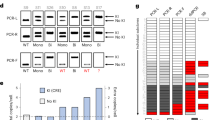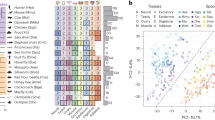Abstract
RETINOIC acid, the first morphogen described so far in verteá-brates, is a vitamin A derivative which exerts striking effects on development and differentiation1–3. The identification of three retinoic acid receptors as members of the nuclear receptor super-family provides an explanation for the molecular action of morphogens on gene expression4–8. Functional analysis of the receptors requires the identification of target genes and of their cis-acting retinoic acid-responsive elements. We have previously shown that the retinoic acid receptor β gene is transcriptionally up-regulated by retinoic acid9 and now report the characterization of a functional retinoic acid responsive element in the β gene that mediates trans-activation by retinoic acid. Using deletion mapping, we have identified a 27-base pair fragment, located 59 base pairs upstream of the transcriptional start, which confers retinoic acid responsiveness on the herpes virus thymidine kinase promoter. This sequence contains a perfect direct repeat of the motif GTTCAC, which is reminiscent of the 5′ half-palindrome of the thyroid and oestrogen hormone responsive elements. Specific binding of the p protein to the retinoic acid responsive element is demonstrated and is independent of the presence of retinoic acid. Both α and β receptors enhance retinoic acid response in CV1 cells, indicating that they can both act through the same DNA sequence.
This is a preview of subscription content, access via your institution
Access options
Subscribe to this journal
Receive 51 print issues and online access
$199.00 per year
only $3.90 per issue
Buy this article
- Purchase on Springer Link
- Instant access to full article PDF
Prices may be subject to local taxes which are calculated during checkout
Similar content being viewed by others
References
Strickland, S. & Mahdavi, M. Cell 15, 393–403 (1978).
Thaller, C. & Eichele, G. Nature 327, 625–628 (1987).
Roberts, A. & Sporn, M. in The Retinoids (eds Sporn, M., Roberts, A. & Goodman, D.) 209–286 (Academic, Orlando, 1984).
Giguere, V., Ong, E. S., Segui, P. & Evans, R. M. Nature 330, 624–629 (1987).
Petkovich, M., Brand, N. J., Krust, A. & Chambon, P. Nature 330, 444–450 (1987).
de Thé, H., Marchio, A., Tiollais, P. & Dejean, A. Nature 330, 667–670 (1987).
Brand, N. et al. Nature 332, 850–853 (1988).
Zelent, A., Krust, A., Petkovich, M., Kastner, P. & Chambon, P. Nature 339, 714–717 (1989).
de Thé, H., Marchio, A., Tiollais, P. & Dejean, A. EMBO J. 8, 429–433 (1989).
Sap, J., Munoz, A., Schmitt, J., Stunnenberg, H. & Vennström, B. Nature 340, 242–244 (1989).
Schmid, W., Strähle, U., Schütz, G., Schmitt, J. & Stunnenberg, H. EMBO J. 8, 2257–2263 (1989).
Gaub, M. P. et al. Proc. natn. Acad. Sci. U.S.A. 86, 3089–3093 (1989).
Beato, M. Cell 56, 335–344 (1989).
Damm, K., Thompson, C. & Evans, R. Nature 339, 593–597 (1989).
Umesono, K., Giguere, V., Glass, C., Rosenfeld, M. & Evans, R. Nature 336, 262–265 (1988).
Evans, R. Science 240, 889–895 (1988).
Graupner, G., Wills, K., Tzukerman, M., Zhang, X. & Pfahl, M. Nature 340, 653–656 (1989).
Sanger, F., Nicklen, S. & Coulson, A. K. Proc. natn. Acad. Sci. U.S.A. 74, 5463–5467 (1977).
Greene, J. & Struhl, K. in Current Protocols in Molecular Biology Vol. 1 (eds Ausubel, F. M. et al.) 4–6 (Wiley, New York, 1987).
de Wet, J., Wood, K., de Luca, M., Helinsky, D. & Subramani, S. Molec. cell. Biol. 7, 725–737 (1987).
Nguyen, V., Morange, M. & Bensaude, O. Analyt. Biochem. 171, 404–408 (1988).
Author information
Authors and Affiliations
Rights and permissions
About this article
Cite this article
de The, H., del Mar Vivanco-Ruiz, M., Tiollais, P. et al. Identification of a retinoic acid responsive element in the retinoic acid receptor & beta;gene. Nature 343, 177–180 (1990). https://doi.org/10.1038/343177a0
Received:
Accepted:
Issue Date:
DOI: https://doi.org/10.1038/343177a0
This article is cited by
-
Retinoic acid receptor β modulates mechanosensing and invasion in pancreatic cancer cells via myosin light chain 2
Oncogenesis (2023)
-
Inhibition of retinoic acid receptor α phosphorylation represses the progression of triple-negative breast cancer via transactivating miR-3074-5p to target DHRS3
Journal of Experimental & Clinical Cancer Research (2021)
-
PRMT3 interacts with ALDH1A1 and regulates gene-expression by inhibiting retinoic acid signaling
Communications Biology (2021)
-
Genomic and non-genomic pathways are both crucial for peak induction of neurite outgrowth by retinoids
Cell Communication and Signaling (2019)
-
Neonatal vitamin A injection promotes cattle muscle growth and increases oxidative muscle fibers
Journal of Animal Science and Biotechnology (2018)
Comments
By submitting a comment you agree to abide by our Terms and Community Guidelines. If you find something abusive or that does not comply with our terms or guidelines please flag it as inappropriate.



